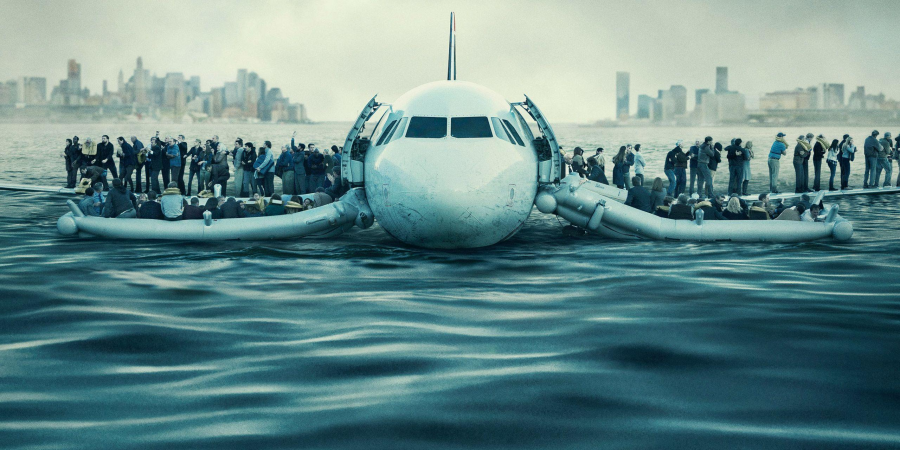

It's true story!!!
Captain Chesley "Sully" Sullenberger and First Pilot Jeff Skiles board US Airways Flight 1549 on the afternoon of January 15, 2009, traveling from LaGuardia Airport to Charlotte Douglas International Airport. Jeff admits that he read about Sully and his own consulting business for aviation safety with no other employees except himself. At about 2,800 feet (850 meters) in the air, three minutes into the flight, the Airbus A320 collides with a flock of birds, disabling both engines.
He activates the APU (auxiliary power unit) shortly after. Sheila and Doreen, the flight attendants, urge the passengers to fasten their seat belts. They have lost both engines' thrust, so Captain Sully immediately calls for Mayday, an emergency signal used around the world. Patrick, the departure controller, inquires as to whether they could attempt a landing on runways 1–3.
Sully responds, as they only have a little time to deliberate and are unable to, and they might wind up in Hudson. "Brace for impact," Sully warns the passengers. Once more, Patrick instructs him to turn right and land in on runway 1. Sully claims that they won't make it and will arrive in Hudson. They also lose radar contact with the aircraft. Vicinities near the George Washington Bridge are warned about US aircraft by Patrick. The pilot informs Patrick that the US Airways flight is about to descend and make contact with the river.
Sully ditches the plane on the Hudson River after concluding that they won't be able to reach any local airports (Teterboro Airport being the closest). As soon as they touched down on the river, Sully and his team led everyone to safety. They managed to save the passengers with assistance from the neighborhood and the Coast Guard. The crew and passengers escaped with only minor injuries and no fatalities. Sully gets restless until he is told that all of the passengers have been saved. The Aircraft Systems Team, aircraft structures, MRT, aircraft performance, ATC, wildlife factors, survival factors, and emergency response are all investigated by the NTSB before they question pilots.
The NTSB looks into Captain Sully and Jeff, their first pilot, the very next day for their human performance investigation. Sully responds to their question, "Why didn't he land in LaGuardia? He claimed that he couldn't go back once he started to make a left turn. The only area that was long enough, smooth enough, and wide enough to even try to land the airplane safely was at Hudson, where there was insufficient altitude.
Sully adds that picking LaGuardia would be a mistake. The NTSB concluded as they headed for the computer, which would run the algorithm for the return scenario and produce a simulation with precise parameters. In addition, they assert that a twin-engine failure brought on by numerous bird hits would be unusual. It appears that it has remained in an idle state. Still, Sully is lauded as a hero, but he continues to feel the repercussions and cannot avoid the media's attention, which focuses on both him and his family.
Through Arnie, Sully gets to know that initial ACARS (Aircraft Communication Addressing and Reporting System) data indicates that the left engine was still operating at idle power while he was still in New York City for investigational purposes. The NTSB claims that acknowledging ACARS’s data, the left engine still had the potential to land the aircraft at Teterboro or LaGuardia. Sully says the ACARS data is wrong. The National Transportation Safety Board (NTSB) also asserts that the attempts made for the Teterboro runway and LaGuardia runway were consistent with results from various private computer simulations, and every computer simulation with the exact flight parameters demonstrated that a return to LaGuardia was possible.
Contrary to their adamant insistence, Sully and Jeff's relationship progressively strengthens their bond. The NTSB believes Sully's career may end as a result of a pilot’s mistake. Sully contacts his wife late at night to inform her that the NTSB has listed him as a probable cause and that the worst-case scenario would be an early retirement with no pension and the loss of his life's work. The same night, Sully suddenly gets an idea; he recalls the time he was left to make decisions before he ditched the plane into the river. The NTSB's public hearing was attended by Captain Sully and Pilot Jeff the following day. They arrange for the simulations to be repeated with actual pilots and then broadcast to the whole audience.
They lead to secure landings. The simulation pilots were aware of the situation they would face and advised emergency action in advance, were able to practice the scenario numerous times, had no passengers to consider, and were in no danger themselves, according to Sully, who questions whether the simulations are realistic because they fail to take into account human factors like the element of surprise, the time required for analysis and decision-making, and the significantly higher stakes he and Jeff faced.
The simulations are replayed with a 35-second break before the plane is diverted after the NTSB acknowledges his criticism. The plane lands short of the runway at LaGuardia, and the plane to Teterboro crashes into structures before the airport. The NTSB reports that an examination of the port engine, which has since been retrieved from the river, supports Sully's claim that the engine had been significantly damaged as a result of the bird hit and that Sully had acted appropriately during the incident. Sully gives all of the passengers, the ferry staff, the emergency response teams, and the air traffic controllers credit for the accomplishment. Finally, the NTSB believes that whatever Sully has done is a miracle.
